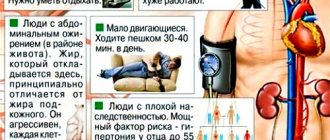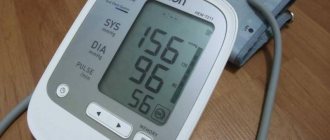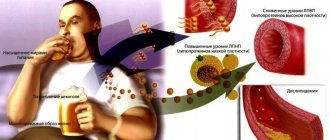Normal blood pressure at rest and when walking
Pressure at rest corresponds to the age norm: ideal –120/80 mm Hg. up to 50 years, 140/90 - after 50. Therapists, cardiologists, neurologists say that the norm when walking can be considered an increase in the systolic indicator within 50 units, and diastolic - 20. Anything that goes beyond the boundaries of these values indicates stress , disease or minimal adaptive potential of the patient.
Squat, large people are practically unfamiliar with blood pressure fluctuations during movement, but in men the upper level is always higher than in women. If half an hour after the end of the physical activity the pulse and blood pressure return to normal without outside help, there is no reason to worry. High numbers that persist for more than an hour suggest contacting a doctor.
Obliterating atherosclerosis of the vessels of the lower extremities
Enter your pressure
130
on
90
Search in progress Not found
Have you been struggling with HYPERTENSION for many years without success?
Head of the Institute: “You will be amazed at how easy it is to cure hypertension by taking it every day...
Often, obliterating atherosclerosis of the vessels of the lower extremities affects about 10% of the population at the age of sixty-five years and older. Men over 50 who smoke are more susceptible to this disease, but the disease also occurs in young men.
Risk factors contributing to the development of the disease
This disease has the same risk factors as other arterial diseases.
The most significant include:
- Burdened heredity
- High blood pressure
- Obesity
- Sedentary lifestyle
- High blood cholesterol
- Diabetes
- Smoking is one of the most serious risk factors that affects the progression and development of atherosclerosis. Quitting smoking is considered a necessary condition in the fight against atherosclerosis.
Symptoms of atherosclerosis of the vessels of the lower extremities
- The first stage - pain in the lower extremities begins with impressive physical activity, such as walking over a distance of more than one kilometer;
- The second stage - pain appears when walking at distances of up to two hundred meters;
- The third stage is pain while walking at distances of twenty-five meters or at rest;
- The fourth stage is the appearance of gangrene of the lower extremities and trophic ulcers.
One of the signs of the disease may be the disappearance of the pulse in the thigh, behind the inner ankle, in the popliteal fossa.
Treatment of atherosclerosis of the vessels of the lower extremities
There are several areas of treatment:
- Increase exercise tolerance, that is, increase the distances walked before the first signs of intermittent claudication appear.
- Reduce the pain that occurs with intermittent claudication.
- Prevent the development of critical arterial blockages leading to the formation of ulcers, amputations and gangrene.
- To prevent the development of myocardial infarction and stroke.
Treatment must be comprehensive and contain devices that affect all parts of the pathogenesis of this disease.
The main activities aimed at changing the patient’s lifestyle:
- Stop smoking - this will eliminate the risk factor for the development of critical ischemia and progression of the disease and the need for amputation.
- Eating healthy foods will help lower blood cholesterol and control blood pressure.
- Performing a specially selected course of physical exercises allows you to effectively use the oxygen delivered to muscle tissue and gradually develop collateral blood circulation in the extremities.
- Diabetes control.
- Drug treatment - There are several sites for the application of drugs, such as antiplatelet and antiplatelet effects on the blood system, treatments aimed at lowering blood cholesterol levels, treatments that help improve blood flow to the lower extremities, and treatments that help maintain normal blood pressure levels.
Blood pressure surges that require medical advice
Blood pressure has the ability to change throughout the day. This is normal if the systolic and diastolic values are stable. Violation of the natural balancing of blood vessels leads to their jumps: from minimum to maximum and vice versa. This situation is dangerous, since the arteries may not withstand sudden changes, burst, and provoke the development of a heart attack or stroke.
Older patients are at risk for hypertension. For hypotensive patients, such changes threaten the development of hypoxia due to insufficient oxygen supply to the tissues. It is jumps in blood pressure that are a reason to consult a specialist, since without the exact cause of the pathology, its adequate treatment is impossible.
Vitamins and minerals in nutrition
Food should contain vitamins and minerals, especially vitamin B6, potassium, magnesium and calcium. Along with other useful features, they have a natural property of lowering blood pressure. Did you know that most people are magnesium deficient? However, special supplements to your diet must be prescribed by your doctor, and this is especially true if the person is already taking any medications. Because some medications can interact with each other, you may need to take vitamin supplements at a different time, separately from your medications, or some may need to be omitted altogether due to incompatibility.
The benefits of walking for hypertension
Walking is an option for a healthy lifestyle and is a natural physical exercise. Blood pressure while walking is a biomarker of fitness or compensatory potential of the cardiovascular system. An increase in the upper or lower indicator during movement indicates insufficient dosed physical activity on the body.
Walking is healthier than spending time passively. They improve skin tone, reduce the risk of sudden death in the elderly, burn calories, fight insomnia, strengthen bones, stabilize hormonal balance, psycho-emotional mood, and prevent glaucoma and diabetes.
Walking also maintains optimal condition of the heart and blood vessels:
- the risk of acute conditions associated with surges in blood pressure is reduced;
- migraine headaches disappear;
- vascular tone, immunity, and the patient’s well-being increase;
- stress resistance increases;
- respiratory function is normalized due to intensive oxygen supply to tissues.
Walking is an excellent type of anaerobic training for a healthy person and a patient suffering from hypo- or hypertension. Doctors emphasize the advisability of different types of walking.
Dosed
The optimal way to improve health for patients with hypertension, hypotension, and other diseases of the cardiovascular system is dosed walking. It is especially indicated for rehabilitation after serious illnesses, surgical interventions, heart attacks, and strokes.
As a rule, such physical impact is short-lived and stimulates the functional potential of any internal organ. A sharp increase in effort is excluded, a gradual increase in distance, the time of movement is coordinated by the doctor.
Scandinavian
This type of walking involves the use of special sticks. Today it is the most effective, safe type of vascular training for patients of all ages, which guarantees:
- increasing myocardial contractility with a simultaneous decrease in arterial load;
- getting rid of extra pounds;
- stable psycho-emotional state, good mood;
- lowering blood cholesterol levels;
- stable decrease in elevated blood pressure by 9 units.
The first lessons take half an hour. Every 5 days their duration is increased by 10 minutes, up to an hour. This is the optimal training time.
Sports
Here you need to monitor your blood pressure and monitor your posture. This “work” is not suitable for everyone; trained patients can move at a speed of 7 km/h, athletes – 15 km/h. The entire training process is subject to coaching control. Not only the speed of movement is important, but the length of the step, rhythm, and change of pace.
Ski
Ski trips are loved by many. This is a very useful type of natural vascular training that prevents the development of hypertension in patients of any age. But skis require some restrictions:
- the temperature should not exceed minus 10 degrees Celsius;
- snowfall and wind are a taboo for “travel” on skis;
- short distances are ideal, taking an hour of time with breaks (you can walk twice a day).
Compliance with all the rules of skiing brings joy and health, guaranteeing active longevity.
How to walk properly with hypertension
To maintain normal oxygen circulation, you should spend more time in the fresh air. The maximum therapeutic effect can be achieved through active walking. Alexander Shishonin, general practitioner, cardiac surgeon, candidate of medical sciences and founder of non-drug treatment of hypertension, gives professional recommendations on how to walk in order to normalize oxygen supply to the brain:
- Walk at an average pace. Fast walking only increases the load on the heart muscle, which is already overloaded. A slow step has virtually no effect on heart contractions, so the effect will be insignificant.
- Walk for at least 1-2 hours. 10-minute walks are useless if you have hypertension; the hidden resources of the human body do not have time to become active in a short time.
- Focus on your breathing. Correct breathing is abdominal breathing, which activates the diaphragm. In addition, focusing on breathing calms the psyche and allows you to take your mind off pressure surges.
Walking for hypertension is not only a therapeutic measure, but also an excellent method of prevention. The more oxygen enters the blood, the less peripheral vessels spasm and the calmer the brain receptors. The air entering the internal organs by the force of the atmosphere is a natural antidepressant.
There is a method in medicine - hyperbaric oxygenation - this is a procedure for saturating all cells and tissues with pure oxygen. It is carried out in a special pressure chamber in which 100% oxygen (in street air its content is 20-30%) penetrates the body under high pressure. After the session, euphoria sets in, which calms the nervous system, stabilizes blood pressure, and also allows you to treat many chronic diseases.
Hyperbaric oxygen therapy is the same as walking, but with a fivefold effect. What are the benefits of walking for hypertension:
- The supply of oxygen to all tissues and cells is restored.
- Capillaries and deep veins in the leg muscles are connected.
- The risk of hypoxia (oxygen starvation) is eliminated.
- The nervous system's resistance to stress increases.
- Inflammation, swelling, infections, and viral bacteria resolve.
- Damaged blood circulation in the arteries is restored.
- The walls of blood vessels and vascular capillaries expand.
- The performance of the brain and all internal organs increases.
- It becomes possible to completely stop taking medications.
Daily walking and walking organically distributes the load between the heart and legs. Dr. Shishonin many times gave an example of how regular physical activity helped patients get rid of hypertension without the use of drugs. Each step works in the same rhythm with the heart muscle, which allows you not to overload the heart and, accordingly, maintain normal blood pressure.
Contraindications
Despite the obvious benefits of walking for the heart and blood vessels, abuse of such physical activity can cause harm. Complete refusal from walking training is applicable only if negative symptoms appear. The choice of the type of physical activity is decided by the doctor. Contraindications to walking are well known:
- frequent pressure surges of unknown origin;
- ACVA – stroke;
- thrombosis of blood vessels of the lower extremities.
This helps the patient and physician reach the necessary consensus when choosing a payload.
Reasons for increased blood pressure while moving
The answer to the question of why movement causes an increase in blood pressure lies in the compensation mechanism. Even moderate walking constricts blood vessels, impairing blood flow to the organs. As a response, a rapid heartbeat occurs, the heart muscle sends more blood to the capillaries to compensate for the increasing hypoxia. If the walk takes more than 45 minutes, all indicators return to normal.
Only in patients with minimal adaptive capabilities does blood pressure remain high during movement. A number of provoking factors contribute to this: time of day, gender, age, body constitution, weather sensitivity, medication, psychosomatics, fitness. A significant jump in blood pressure is recorded with age-related changes, a sedentary lifestyle, and concomitant diseases.
Low Pressure Triggers While Walking
Low blood pressure after walking or dosed physical activity is not uncommon. This is explained simply: the body experiences overload and tries to save energy. This condition cannot be ignored, since its triggers can be a number of diseases:
- vegetative-vascular dystonia: the lumen of the vessels does not have time to adapt to the situation, hypotension occurs;
- heat stroke leads to a decrease in blood pressure to critical levels: less than 90/60;
- mitral valve prolapse;
- paradoxical hypertension at the onset of pathology;
- physical activity after a long absence from sports;
- weakness of the sinus node;
- angina pectoris with outcome in AMI.
All these conditions require medical intervention, sometimes emergency measures.
Prevention
To prevent hypertension, you should follow a diet. With proper nutrition in the human body, blood clotting is reduced, the functioning of the liver and kidneys is normalized, and the condition of the walls of blood vessels is improved.
Diet rules for hypertensive patients:
- Eating protein foods.
- Reducing animal fats and fast carbohydrates in the diet.
- Consumption of necessary vitamins and microelements in sufficient quantities.
- Adding foods high in choline and methionine to your diet.
- Consuming foods containing iodine.
- Control over the level of fluid consumed - no more than 1.5 liters per day.
- Salt-free diet.
Hypertension, like any other disease, is easier to prevent. By following these recommendations and your doctor's advice, you can keep your blood pressure levels under control.
Diseases that provoke a pathological condition
Not only hypotension, but also pressure surges during movement can be caused by somatic pathology. Then consultation with a specialist is necessary to accurately diagnose the disease that caused the problem, since often such pathology indicates a danger to life and requires emergency care. The causes of hypertension are:
- thrombosis of deep or superficial vessels of the lower extremities;
- renal pathology with outcome in chronic renal failure (chronic renal failure);
- cerebrovascular accident;
- hormonal imbalance;
- stable hypertension of unknown origin;
- diseases of the musculoskeletal system.
The presence of these diseases is a reason for a thorough analysis of the patient’s compensatory capabilities when choosing physical activity.
Negative symptoms
Usually, any walking, subject to the doctor's recommendations, does not cause negative symptoms in patients. However, there is one category of people who react even to a leisurely walk with hypertension, shortness of breath, cyanosis of the skin and mucous membranes, tachycardia, and an increase in the volume of blood circulating through the vessels.
A change in posture and faster pace of steps are manifested by other signs:
- pre-fainting;
- migraine;
- chilling;
- weakness;
- swelling of the face;
- loss of sensitivity in fingers;
- inability to navigate in space.
The combination of such symptoms with vegetative-vascular dystonia suggests immediate seeking medical help.
Recommendations on how to normalize blood pressure, prevention
To stop blood pressure surges while moving, you should stop, catch your breath and change the speed of movement. Then, together with the attending physician, develop behavioral tactics. It is necessary to determine whether secondary or primary hypertension is provoked by movement. This will confirm or refute the increase in cardiovascular parameters, its systolic, diastolic or mixed nature, as well as complete clinical and laboratory testing of the patient.
If the diagnosis is established, the doctor will select an individual program for correcting the pathology using medications and other methods of therapy. In this case, you need to focus on certain rules in order to avoid the negative consequences of walking:
- move only measuredly, slowly;
- do not forget about the ban on sports or other walking without consulting a doctor or appropriate preliminary training;
- Walking every day is a natural workout for the cardiovascular system;
- gradually increase the load;
- move, periodically stopping and resting;
- the patient must know that a sharp deterioration in general condition with dizziness, visual and auditory disorders is a sign of a pre-stroke;
- Physical activity is contraindicated for pregnant women; it tones the uterus and can cause miscarriage or premature birth;
- taking antihypertensive drugs simultaneously with changes in blood pressure indicates incorrectly selected therapy or a minimum dosage that is not able to control blood pressure.
The correct speed of movement, from the point of view of doctors, is calculated using a special formula: the maximum pulse numbers minus the patient’s full age are multiplied by 0.65. The result is the permissible maximum load.
For example, maximum heart rate is 200. Age 45 years. Difference = 155. Multiply by 0.65, we get 100.75 or rounding, 101 steps. It is believed that 50 steps correspond to a speed of 3 km per hour. This means that we need to walk at a speed of 6 km per hour or cover 3 km in half an hour.
Walking: Walking 30 minutes a day can help lower blood pressure, blood sugar and weight
Walk in the park
What if you're not the type of person who can hit the gym every day? What if you don't like running or you're just not in the right health to do it? But there is one simple way to always remain physically active, which does not require much effort and is very good for your health - walking.











